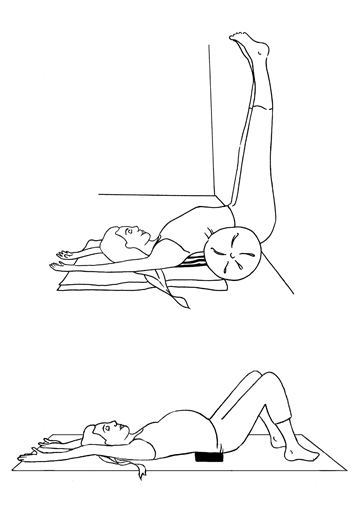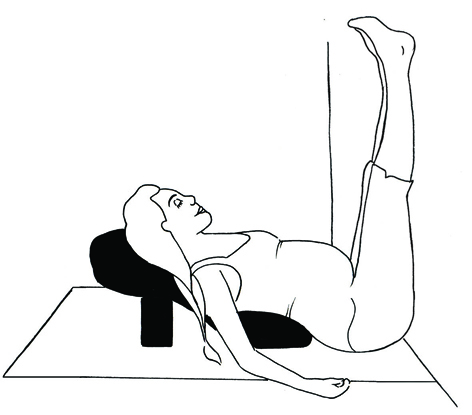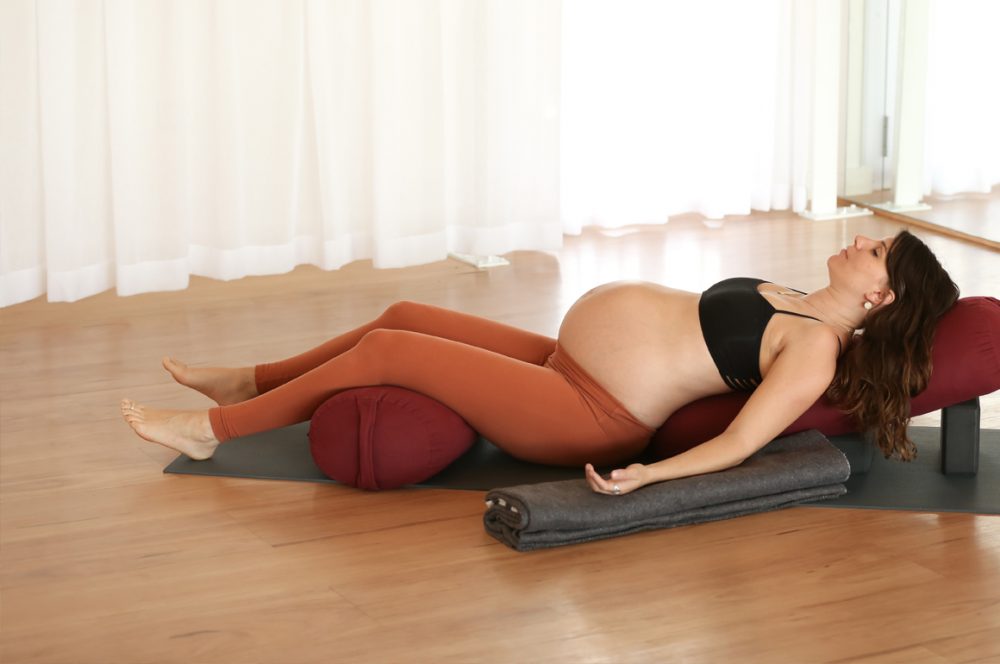Some thoughts on practising supine yoga postures during pregnancy…
It has generally been understood that it’s not appropriate for a pregnant yoga student to practice any supine positions (ie: lying on her back) for a prolonged period of time, after the 14th week of her pregnancy. In our Bliss Baby Yoga Prenatal Yoga Teacher Training courses we recommend you have your pregnant students lie on their side for Savasana (supine relaxation practice) or, that they adopt an inclined supported position such as the ‘armchair / queen’ posture. The same goes for any normally-supine, pranayama (breathing) practices.
The reason we avoid lying on our backs during pregnancy is due to something called ‘vena cava syndrome’ or otherwise known as ‘pregnancy hypotension’, in which the weight of the pregnant uterus can compress the vein that runs up the right side of the body and potentially restrict the blood flow for mother and baby.
However, due to information coming from the American College of Obstetricians and Gynaecologists (ACOG), the Society of Obstetricians and Gynaecolgists of Canada (SOGC) and the Association for Chartered Physiotherapists in Women’s Health, which states that a pregnant woman should completely avoid lying on her back, even for a short period, we’ve had to re-think our approach to supine yoga postures during pregancy.
 On researching further, I also discovered that the medical recommendation is to avoid even the modifications of raising the hips up on a bolster or block, for example in Viparita Karani, ‘legs up the wall’ (top illustration, pictured right), or supported Settu Bhandasana, ‘bridge pose’ (bottom illustration, pictured right). I consulted with experienced midwife and yoga teacher, Vicki Thomson, and this is what she said about this:
On researching further, I also discovered that the medical recommendation is to avoid even the modifications of raising the hips up on a bolster or block, for example in Viparita Karani, ‘legs up the wall’ (top illustration, pictured right), or supported Settu Bhandasana, ‘bridge pose’ (bottom illustration, pictured right). I consulted with experienced midwife and yoga teacher, Vicki Thomson, and this is what she said about this:
“I have spent many hours researching this area and there seems to be little substantial evidence that supine position in pregnant women is dangerous, but I thought to those that it is [with the benign (women asymptomatic) type] it is not worth the risk because they may in the course of their pregnancies spend extended time in these asanas. Also Midwives and Obstetricians are professionally bound to have ‘evidence based practice’ so they are not prepared to change until research supports change.”
She continues: “I have spoken with a few Obstetricians who agree with my logic that raising the hips will not prevent supine hypertension as the compression is between the spine and the gravid uterus and elevation wont alter this. I asked this without giving my thoughts first.”
So… the upshot is, that we need to take care when teaching our pregnant students postures like Viparita Karani, ‘legs up the wall’, even with a bolster under her pelvis, and supported settu bhanda, ‘bridge pose’.
In my teaching and my own practice, the best guide for safety has always been the intuition – tuning into the pregnant body and adjusting or avoiding a posture depending on how the woman is feeling and responding to the posture. I know that in my own pregnancy, simply by raising the hips so that the uterus and chest were not on the same plane, meant that I no longer experienced the common vena cava compression symptoms of dizziness and discomfort.
Many experienced prenatal yoga teachers still support the use of these postures during pregnancy. For example in Geeta S. Iyengar’s latest publication, “Iyengar Yoga for Motherhood” (published in 2010) she recommends the practice of Viparita Karani, ‘legs up the wall’, (among other inversions) as extremely beneficial during pregnancy.
Personally I think it’s a great shame that we lose so many potential benefits from this gentle inversion, by eliminating this posture altogether from our prenatal repertoire.
According to Geeta Iyengar, inversions, like viparita karani “bring about harmony among the circulatory, endocrinologic, and nervous systems and improve the health of the nervous and respiratory systems. They help regulate blood pressure and improve blood supply, distribution, and circulation which helps prevent varicose veins.”
 However, we do live in litigious times and we need to be extra vigilant as complementary health care professionals and ensure we always conduct ourselves with professional responsibility and care for our students.
However, we do live in litigious times and we need to be extra vigilant as complementary health care professionals and ensure we always conduct ourselves with professional responsibility and care for our students.
But there is a compromise, so that we don’t have to ‘throw the baby out with the bath-water’ (pardon the pun!). We can adapt Viparita Karini by propping up the upper body with an inclined bolster(s) whilst still having the legs raised up a wall, or even have the calves resting on the seat of the chair. In this way, the body is in a kind of supported v-shape (pictured) and we do not risk compressing the vena cava as the uterus is no longer in a full supine, or semi inverted position (see illustration, pictured right). Play around with this variation with your pregnant students and see how they like it.
Finally, I want to make an important note that the information from the aforementioned Obstetrician associations suggests that even the other supine-modification that we regularly employ in prenatal yoga with the torso raised on an inclined bolster (with a brick or another bolster raising up one end of the bolster) should not be practiced from the 38th week of pregnancy. So, to be on the safe side, it’s best to recommend those women who are late in their pregnancy sit upright (against a wall, for instance for support) or lie on the left side (optimal side), when we are having the other women, who are earlier in their pregnancy, practice a posture like supta baddha konasana, ‘inclined groin stretch’, or the arm-chair/ queen posture (see photograph above at the top of this blog) .
Do feel free to join us in our Bliss Baby Yoga Facebook Group to share in this discussion with any questions or comments on this issue of, “to supine or not to supine”.
Ana Davis, Founder of Bliss Baby Yoga, has a passion for a feminine approach to yoga, and supporting women with yoga through all ages and stages of their life. She is a lead trainer on our popular Online Prenatal & Postnatal Yoga Teacher Training Course – designed to equip yoga teachers with the skills and knowledge to safely and confidently teach yoga for all stages of pregnancy, and postpartum phases, as well as our Online L1 & L2 Restorative Yoga Teacher Training courses and Online Level 1 Yoga for Fertility Teacher Training.
Ana is also the author of the groundbreaking ‘health bible’ for women, “Moving with the Moon – Yoga, Movement and Meditation for Every Phase of Your Menstrual Cycle and Beyond”.
Illustrations by Sophie Duncan
Further Reading related to this topic:
- Lets Twist Again! Twisting Safely During Pregnancy by Ana Davis
- Feel-good Mama: Restorative Yoga for Mums-to-be by Ana Davis
- Safe Yoga for Placenta Previa by Nadine O’Mara
- Healing the wound: How can we best support mothers after caesarian? by Nadine O’Mara
- Restorative Yoga: Powerful Medicine by Ana Davis


Comments are closed.